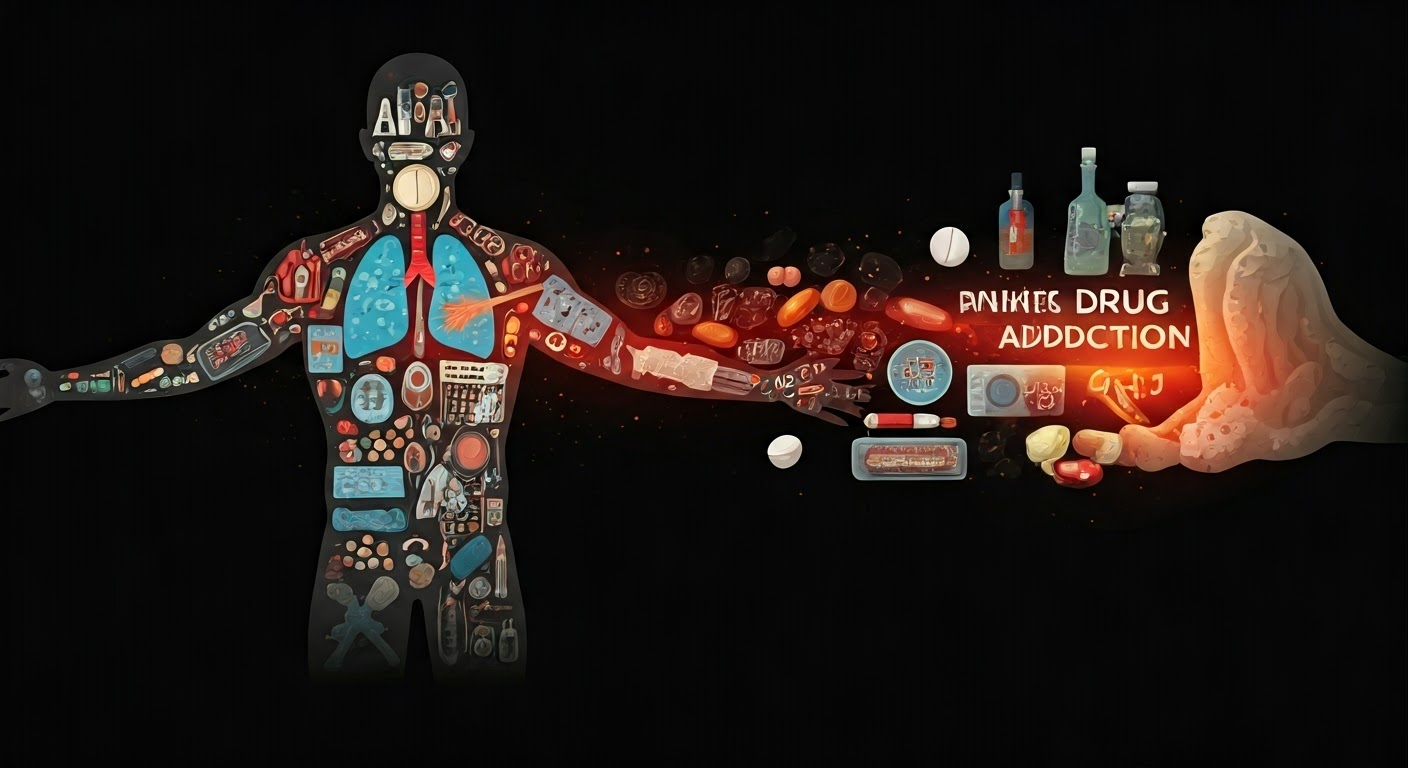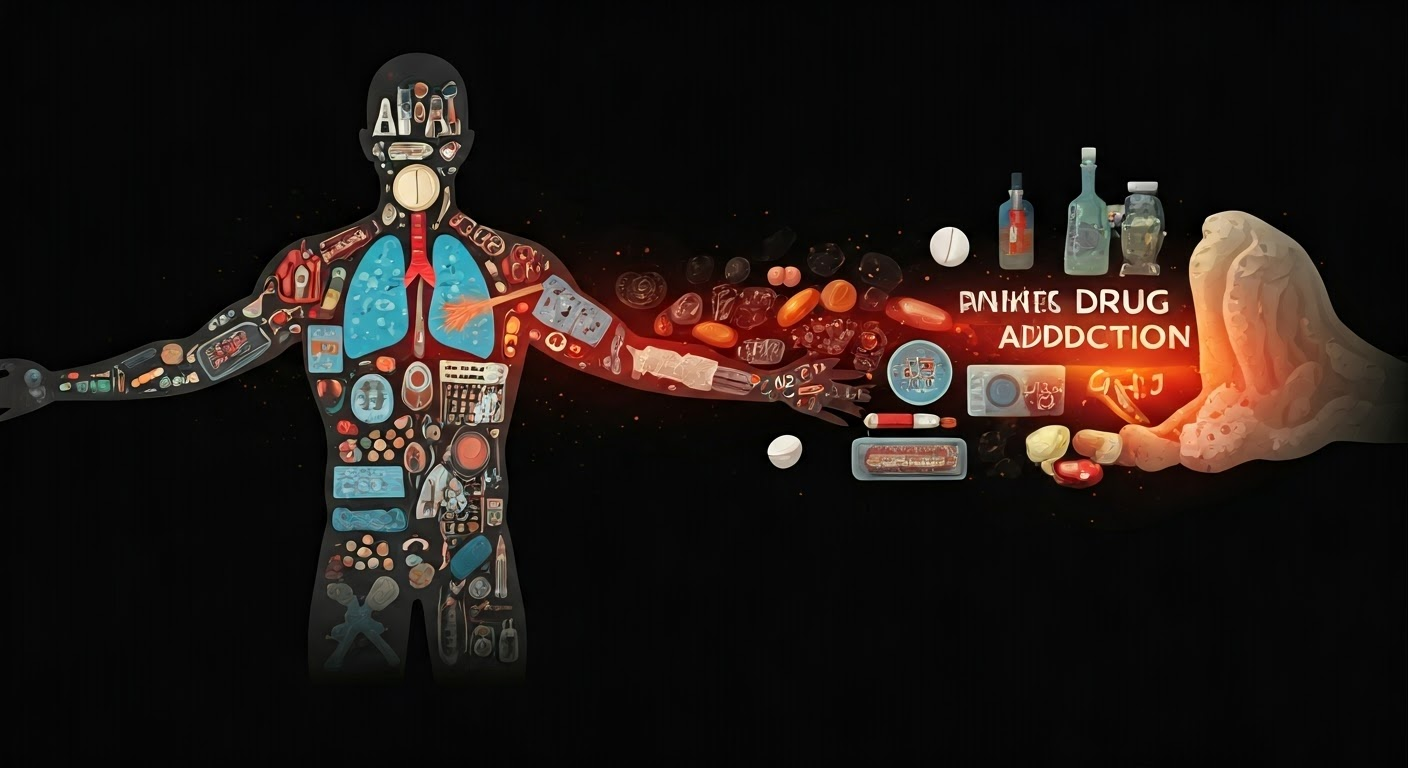The Harsh Reality: Consequences of Drug Addiction

Key Highlights
- Drug addiction, also known as substance use disorder, is a chronic and relapsing disease.
- It is characterized by compulsive drug use despite negative consequences.
- Drug addiction can affect anyone, regardless of age, gender, ethnicity, or socioeconomic status.
- There are effective treatments available, including behavioral therapies and medications.
- Prevention efforts focus on promoting healthy lifestyles.
Introduction
Drug addiction is a serious health problem that affects many people. It is often called substance use disorder. This condition means that a person feels a strong urge to use drugs, even when it harms their health and affects their mind and relationships. Drug addiction can have harsh effects not just on the person but also on their families and the wider community.
Understanding Drug Addiction

Drug addiction is not just about willpower or making poor choices. It is a complicated disease that affects how the brain works and its structure. These changes make it hard for people to control their urges and make healthy choices, especially about substance use.
Seeing drug addiction as a disease is important. It helps people understand it better, reduces shame, and encourages them to find the right help and treatment. Good treatment usually mixes behavior therapy, medicine, and support tailored to meet each person’s needs.
Defining Addiction and Its Scope
Substance use disorder is a medical term. It describes patterns of using drugs or alcohol that cause major problems in life. This includes having trouble controlling use even when it leads to health issues, relationship troubles, or legal and money problems.
People with substance use disorders may use illegal drugs or misuse medicines they get from doctors. There are specific signs that help identify substance use disorder, such as:
- Tolerance: Needing more of the substance over time.
- Withdrawal symptoms: Feeling physical or mental effects when not using.
- Neglecting responsibilities: Missing duties at work, school, or home.
- Interpersonal conflicts: Substance use causing issues with family or friends.
The United States is dealing with a big public health issue because of drug addiction.
The Journey from First Use to Dependency
The road to drug addiction often starts with trying drugs. This usually happens during the teenage years or young adulthood. People may try drugs out of curiosity, to fit in, or because of peer pressure. At first, they may think they can control their drug use and stop anytime.
However, continued drug use changes the brain. This makes it harder to resist cravings. As time goes on, people begin to need more of the drug to feel the same effects. This leads to a cycle of more use, growing tolerance, and strong cravings, which can quickly result in dependence.
Dependence is marked by strong cravings and withdrawal symptoms when someone stops using the drug. At this point, people often keep using drugs even when it causes problems. They may find it very difficult to quit on their own.
Signs and Symptoms of Drug Addiction

Recognizing the signs of drug addiction is very important for getting help early. Different drugs show different signs, but some changes are seen often.
Behavioral signs include not taking care of duties, staying away from friends, taking risks, and having issues with the law or money. Physical signs might be changes in sleep, gaining or losing weight, big pupils, and looking unwell.
Behavioral and Physical Indicators
Drug addiction shows up in clear changes in how a person acts and feels physically. As a person gets used to a drug, they may start using it more often and in larger amounts. This can make them focus more on getting and using the drug. They might stop taking care of themselves, skip work or school, and strain their relationships.
You may see physical signs like changes in blood pressure, heart rate, and body temperature if someone is addicted. They might also deal with changes in how much they eat, their sleep, weight, and energy levels. Long-term drug use can hurt physical health too, leading to a weaker immune system, stomach issues, and heart problems.
Withdrawal symptoms show how the body depends on the drug. If a person suddenly reduces or stops using a drug, they may have various physical and mental symptoms. These can include nausea, vomiting, shaking, anxiety, trouble sleeping, and seizures. These symptoms can be very uncomfortable and may stop someone from trying to quit.
The Impact on Mental Health
Drug addiction greatly affects mental health. It often happens along with mental health conditions like depression, anxiety disorders, and bipolar disorder. Using substances can make existing mental health issues worse and raise the chance of getting new problems.
Drugs mess with the brain’s chemical balance. This can disturb our mood, thinking, and emotional state. As a result, a person may feel more sadness, hopelessness, anxiety, irritability, and anger. Someone with drug addiction might also struggle with poor judgment, low motivation, and trouble focusing.
Additionally, drug addiction can make mental health issues worse in a cycle. People might use drugs or alcohol to help cope with mental health symptoms. But in the end, using substances can intensify these problems. This complex situation shows that it’s important to deal with both drug addiction and mental health issues at the same time.
The Science Behind Addiction
Understanding how drug addiction works is key to knowing why it affects people so much. Drugs take over the brain’s reward system. They fill it with dopamine, which is a chemical linked to feeling good, motivation, and learning.
This big rise in dopamine makes people feel very happy, which encourages them to use drugs more. As time goes on, the brain gets used to having so much dopamine. This leads to needing more of the drug to feel the same way. It also means that if someone stops using drugs, they can have withdrawal symptoms.
How Drugs Alter Brain Function
Different drugs affect the brain in various ways. However, they all disrupt how neurons, the specialized cells that carry information in the nervous system, communicate. This disruption happens at synapses, the small spaces between neurons. In these spaces, chemical messengers called neurotransmitters are released and received.
Some drugs act like neurotransmitters. They can block the reuptake of these messengers or increase their release. This causes an imbalance in brain activity. For example, opioids like heroin and certain painkillers connect with opioid receptors in the brain. They mimic endorphins, the body’s natural pain relievers. This leads to feelings of joy and pain relief. But it also messes with brain circuits that control breathing and heart rate, which can be dangerous in overdoses.
Using drugs for a long time can cause serious brain damage. It can harm your ability to think, remember, make decisions, and control impulses. These changes show how important it is to get early help and treatment. Doing so can help reduce the risk of lasting effects on the brain and nervous system.
The Role of Genetics and Environment
Drug addiction is a difficult problem affected by both genes and the environment. Some genes can make a person more likely to become addicted. If a family member has a history of addiction, it can also increase this risk.
The environment plays a big role too. Being around people or places where drug misuse is common can heighten the chance of drug addiction. For example, living in a community with lots of substance abuse or having friends who encourage drug use can be risky.
Experiences during childhood, like trauma, abuse, or neglect, can also affect the risk of addiction. A history of trauma can change how the brain grows and how a person copes with challenges. This can lead to problems with mental health and make them more prone to substance misuse.
Types of Drugs and Their Effects
Different types of drugs have specific effects on the brain and body. These include stimulants, depressants, hallucinogens, and opioids.
Stimulants, like cocaine and methamphetamine, raise alertness, energy levels, and heart rate. Depressants, such as alcohol and benzodiazepines, slow down brain activity. This can lead to feelings of relaxation, drowsiness, and pain relief. Hallucinogens, such as LSD and psilocybin mushrooms, change how we see and sense things. Opioids, which include heroin, fentanyl, and some prescription painkillers, can be very addictive. They may also cause serious breathing problems and overdose.
Stimulants: From Cocaine to Prescription Medications
Stimulants are drugs that can speed up the central nervous system. They make you feel more alert, energetic, and sometimes incredibly happy. There are different drugs in this group, and they affect people in various ways.
Cocaine is a strong stimulant. People usually snort, smoke, or inject it. It can give a very intense high, but this feeling doesn’t last long. Afterward, users might feel anxious, restless, or even sad.
Methamphetamine is another powerful stimulant. It is often smoked or injected. The high from meth can last longer than cocaine, sometimes for several hours. It can lead to being very hyper, not wanting to eat, and having trouble sleeping. Using meth for a long time can hurt your teeth, cause skin sores, and make you feel very paranoid.
Some prescription stimulants, like Adderall and Ritalin, help treat attention-deficit/hyperactivity disorder (ADHD). However, if these are misused, they can act like cocaine and meth. This misuse can cause addiction, heart problems, and other health issues.
Depressants: Alcohol, Benzodiazepines, and Opioids
Depressants are drugs that slow down how the brain works. They can make you feel relaxed, sleepy, and less anxious. Alcohol is the most common depressant. It is legal for adults, but it can lead to alcohol use disorder. This means a person may develop a tolerance, have withdrawal symptoms, and struggle to control how much they drink.
Benzodiazepines are medicines that treat anxiety and insomnia. Some examples are Xanax, Valium, and Klonopin. These drugs can also lead to dependence and addiction. If someone uses benzodiazepines for a long time, they might need to take more to feel the same effects, and if they stop suddenly, they can have withdrawal symptoms.
Opioids, like heroin, fentanyl, and prescription painkillers such as oxycodone and hydrocodone, are strong depressants. They have a high risk of abuse and addiction. Opioid use has become a major issue in recent years. This is mostly due to too many prescriptions for painkillers and the rise of illegal fentanyl.
Hallucinogens and Their Psychedelic Effects
Hallucinogens, also called psychedelics, are a variety of drugs that change how people see things, think, and feel. They are known for causing hallucinations, which are fake sensory experiences that feel real. One popular hallucinogen is Lysergic Acid Diethylamide (LSD). It can come on blotter paper or in liquid form. LSD can greatly change your awareness. People may see and hear things that aren’t there, change their sense of time, and have mystical feelings.
Another type is psilocybin mushrooms, which are often eaten fresh or dried. These mushrooms contain psilocybin, a natural drug that creates effects like LSD. Users might notice changes in how they see things, mood swings, and spiritual insights. Still, the strength and length of these effects can change based on how much someone takes and their own sensitivity.
It’s important to remember that using hallucinogens can lead to unexpected feelings, such as anxiety, paranoia, and flashbacks. The long-term effects of these psychoactive substances on mental health are still being researched. It is important to be very careful with them and to seek help from a professional if you have trouble with using these drugs.
Consequences of Long-Term Drug Use
Long-term drug use can cause serious problems. It affects physical health, mental health, relationships, money, and general well-being. The effects can differ based on the drug used, how often it’s taken, and the person’s traits.
One major worry is the harm to physical health. Drug addiction can hurt important organs. It weakens the immune system and raises the chance of infections. It can also result in heart disease, liver disease, strokes, lung damage, and several kinds of cancer.
Physical Health Decline and Diseases
Over time, using drugs can harm your body a lot. It can lead to worse health and a higher chance of getting different diseases. Using certain drugs, especially by injection, can hurt blood vessels. This can lead to serious problems like a heart attack, stroke, or heart failure.
Substance abuse makes it harder for the body to fight infections. People using drugs may get sick more often with illnesses like pneumonia, tuberculosis, and HIV/AIDS. When people share needles, which is common among those who use drugs, they have a higher risk of getting bloodborne diseases like HIV and hepatitis C.
Drug addiction is also bad for the liver’s health. The liver is important for cleaning toxins from the body. When someone uses drugs a lot, it puts too much stress on the liver. This can cause issues like hepatitis, cirrhosis, and liver failure, which may need a transplant if it’s severe.
Mental Health Issues and Cognitive Decline
Long-term drug use not only gives immediate highs but also really hurts mental health. It raises the chances of getting mental health disorders and makes existing ones worse. When someone abuses drugs, it messes up the balance of chemicals in the brain. This can lead to problems like depression, anxiety, mood swings, and even serious conditions like psychosis.
Also, using drugs for a long time can harm thinking skills. Drugs can affect how we learn, remember, focus, and make decisions. Research shows that people who have used substances a lot may find it hard to solve problems, process what they hear, and control their impulses.
These thinking problems can change a person’s life significantly. They can hurt school performance, job opportunities, and overall life quality. Plus, these issues can make it harder to get better from addiction. It can be tough for individuals to stick to therapy, make good choices, and stay sober.
Social and Economic Fallout
Drug addiction affects more than just the person using drugs. It can seriously hurt families, communities, and society. The social effects are deep. Substance abuse can cause problems in relationships with partners, children, parents, siblings, and friends. It often leads to family fights, poor communication, and a loss of trust.
Family members of people with addiction often feel emotionally upset. They face financial struggles as they try to help their loved one with their addiction. This can make them feel less safe and stable at home. The economic effects of drug addiction are a big problem for both people and society.
Those with substance use disorders may not do well at work, which can lead to losing their job. They might have money issues as they spend their savings, build up debt, or do desperate things to feed their addiction. Society pays the price for drug addiction through high healthcare costs, expenses related to the criminal justice system, and lost productivity.
Strategies for Prevention and Recovery
Preventing drug addiction and helping people recover is important for handling this health crisis. Good prevention focuses on informing everyone about the dangers of drug use. It also encourages healthy habits and teaches people how to resist peer pressure and make smart choices.
Recovering from drug addiction usually requires different methods. These methods should fit the person’s needs. This can include behavioral therapy, like cognitive-behavioral therapy (CBT). Medications can help with cravings and withdrawal symptoms. Support groups and long-term care plans are also important for recovery.
Education and Awareness Programs
Education and awareness programs are key for preventing drug addiction. They help people get the knowledge and skills they need to make healthy choices. These programs share correct information about drugs, clear up myths, and encourage open discussions.
School programs focus on young people. They teach them about the risks of substance use, help them learn how to say no, and boost their self-esteem. They also stress how important it is to ask for help. Community programs inform parents, teachers, and leaders about current drug trends.
These programs give tips on spotting drug misuse, stepping in early, and finding treatment services. By creating a supportive environment, education and awareness programs help individuals avoid drugs and choose options that promote their well-being.
Support Systems: Family, Community, and Rehabilitation
Support systems are very important in recovery from addiction. They give people the support, guidance, and accountability they need to stop using substances. Family involvement is key. Family members can offer emotional help and encouragement. They can also create a safe place for healing. Family therapy helps to fix relationships, boosts communication, and sets healthy boundaries.
Community support groups, like Narcotics Anonymous (NA) and SMART Recovery, give people a sense of belonging. Rehabilitation centers provide structured treatment in a safe place. They may help with detoxification to handle withdrawal symptoms. These centers also offer individual and group therapy, medication-assisted treatment (MAT), and planning for aftercare to assist in long-term recovery.
In conclusion, drug addiction has severe effects. It impacts physical health, mental health, and social connections. To address this problem, we need to understand how addiction works, know the signs, and look for prevention and recovery options. By focusing on education, raising awareness, and offering support, we can build a society that cares about prevention and recovery. It is important to make sure both people and communities work together against the harmful effects of drug addiction. If you or someone you know has a problem with drug addiction, please seek help. There are resources and support systems available to start recovery.
Physical Toll of Drug Addiction

Drug addiction is a serious problem that can harm a person’s physical health. It can lead to many health issues that hurt overall well-being. Drug abuse can result in heart problems and breathing issues.
Liver damage is a major concern linked to drug abuse. Also, using injection drugs can bring a high risk of spreading blood-borne diseases like HIV/AIDS and hepatitis C. These long-lasting conditions require regular medical help and can shorten life expectancy.
Mental Health Impact of Drug Addiction
The impact of drug addiction on mental health is very serious. It often happens with or makes existing mental health conditions worse. This can include problems like depression, anxiety, and psychosis. If these disorders get worse, it can lead to hospital visits, feeling lonely, or having thoughts of suicide.
Many people with mental health problems may use drugs or alcohol to help numb their pain. This is known as the self-medication hypothesis. However, using substances often makes their mental health issues worse. This creates a tough repeat cycle of addiction and problems with mental health.
Social Consequences of Drug Addiction
The effects of drug addiction on society are far-reaching. It can hurt personal relationships. This often leads to broken trust, regular fights, and emotional separation. Those struggling with addiction may also face money problems. To feed their habits, some might get involved in dangerous or illegal activities like stealing or selling themselves.
Family members often carry a heavy load. They may take care of their loved ones who are battling addiction, financial troubles, and mood swings. The effects of addiction don’t just stop with the family. They reach out to neighborhoods and communities. This can lead to more crime, higher healthcare costs, and less unity among people.
What are the first signs of drug addiction?
Early signs of drug addiction can show up as changes in behavior. You might notice a person pulling away from family and friends. They could also ignore their responsibilities and have changes in how they sleep or eat. Physical signs include withdrawal symptoms, regular health problems, or requiring more of the drug to get the same effect. These are all warning signs.
How does drug addiction impact an individual’s physical health?
Drug addiction can cause serious health problems. These include heart attack, stroke, and liver disease, such as hepatitis C. It can also damage the lungs and increase the risk of infections because it weakens the immune system.
Resources for drug addiction include support from family and friends. They also include rehab centers, therapy, and medication-assisted treatment. Organizations like the American Addiction Centers can offer help too.
https://adf.org.au/drug-facts/empathogens
https://order.store.mayoclinic.com/flex/mmv/HRBAL02
https://nida.nih.gov/publications/drugs-brains-behavior-science-addiction/drugs-brain
https://order.store.mayoclinic.com/flex/mmv/fhblc01
https://www.samhsa.gov/find-help/national-helpline
https://order.store.mayoclinic.com/flex/mmv/hldigar
https://www.drugabuse.gov/drugs-abuse/opioids/opioid-overdose-crisis

